-
Countries
-
Data and Analysis
-
Special Focus
-
Crisis Responses
Dashboard/Fact Sheet
Color
-
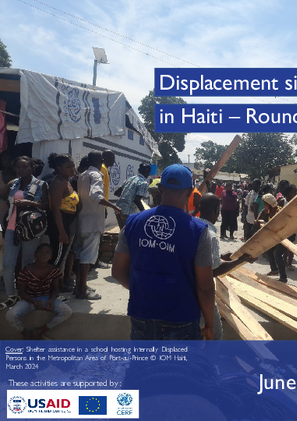
Contact
DTM Haiti, dtmhaiti@iom.int
Language
English
Location
Haiti
Period Covered
Apr 24 2024
May 31 2024
Activity
- Mobility Tracking
- Baseline Assessment
- Site Assessment
- Village Assessment
The Round 6, published in early March 2024, indicated that 362,551 people were
internally displaced in Haiti. This new Round indicates the presence of 578,074 internally displaced people, almost 60%
more than in Round 6. This increase is due to the deterioration of the security situation observed in the MAPAP, Haiti’s
capital, between the end of February and April 2024 in particular. The increase in the number of IDPs was more
identified in provinces where it increased by 95% (compared to 15% in the MAPAP). Indeed, following the increase in
violence in the MAPAP, many people fled the capital to seek refuge in provinces.
The Great South was the region that saw the largest increase in the number of IDPs hosted there (130% more
compared to Round 6). Nearly half (47%) of IDPs in the country are located in the Great South.
The majority of IDPs in the country are hosted in provinces: 68% in provinces vs. 32% in the MAPAP
The IDPs in provinces are mainly people who fled the MAPAP: 78% of IDPs in provinces came from the MAPAP.
Artibonite, where half of the IDPs fled areas located in this department, is an exception. In all other departments of the
country, IDPs mainly came from the MAPAP.
At the national level, the majority of IDPs are hosted by host families: 80% vs 20% in sites. However, in the MAPAP,
the majority of IDPs reside in sites (61% in sites vs 39% in host families), while in provinces the opposite is true (97% in
host families vs 3% in sites). It is crucial to support host communities in provinces, particularly in the Great South, to
enable them to continue hosting IDPs; and it is important to promote social cohesion between these two population
groups. Without the resilience of host communities, the number of sites in provinces is likely to increase as has been the
case in the MAPAP. Indeed, at the beginning of the crisis, the majority of IDPs in the MAPAP were hosted by host
families: only about 2 out of 10 IDPs were in sites in 2022; this figure increased to 6 out of 10 IDPs in 2023. One of the
main reasons for this increase was the lack of resources of host communities to continue hosting IDPs and the
deterioration of social cohesion in this context.
In addition, 50,000 returnees formerly IDPs were identified, particularly in the MAPAP, in Croix-des-Bouquets (21%),
Cité Soleil (14%), Port-au-Prince (12%); in the South in Tiburon (19%); and in the Center in Sauts d’Eau (10%). It should
be noted that for the moment these returns remain very fragile and are not sustainable, particularly in the MAPAP.

Contact
DTM Haiti, dtmhaiti@iom.int
Language
English
Location
Haiti
Period Covered
Feb 24 2024
May 31 2024
Activity
- Mobility Tracking
- Baseline Assessment
- Site Assessment
- Village Assessment
The Round 6, published in early March 2024, indicated that 362,551 people were
internally displaced in Haiti. This new Round indicates the presence of 578,074 internally displaced people, almost 60%
more than in Round 6. This increase is due to the deterioration of the security situation observed in the MAPAP, Haiti’s
capital, between the end of February and April 2024 in particular. The increase in the number of IDPs was more
identified in provinces where it increased by 95% (compared to 15% in the MAPAP). Indeed, following the increase in
violence in the MAPAP, many people fled the capital to seek refuge in provinces.
The Great South was the region that saw the largest increase in the number of IDPs hosted there (130% more
compared to Round 6). Nearly half (47%) of IDPs in the country are located in the Great South.
The majority of IDPs in the country are hosted in provinces: 68% in provinces vs. 32% in the MAPAP
The IDPs in provinces are mainly people who fled the MAPAP: 78% of IDPs in provinces came from the MAPAP.
Artibonite, where half of the IDPs fled areas located in this department, is an exception. In all other departments of the
country, IDPs mainly came from the MAPAP.
At the national level, the majority of IDPs are hosted by host families: 80% vs 20% in sites. However, in the MAPAP,
the majority of IDPs reside in sites (61% in sites vs 39% in host families), while in provinces the opposite is true (97% in
host families vs 3% in sites). It is crucial to support host communities in provinces, particularly in the Great South, to
enable them to continue hosting IDPs; and it is important to promote social cohesion between these two population
groups. Without the resilience of host communities, the number of sites in provinces is likely to increase as has been the
case in the MAPAP. Indeed, at the beginning of the crisis, the majority of IDPs in the MAPAP were hosted by host
families: only about 2 out of 10 IDPs were in sites in 2022; this figure increased to 6 out of 10 IDPs in 2023. One of the
main reasons for this increase was the lack of resources of host communities to continue hosting IDPs and the
deterioration of social cohesion in this context.
In addition, 50,000 returnees formerly IDPs were identified, particularly in the MAPAP, in Croix-des-Bouquets (21%),
Cité Soleil (14%), Port-au-Prince (12%); in the South in Tiburon (19%); and in the Center in Sauts d’Eau (10%). It should
be noted that for the moment these returns remain very fragile and are not sustainable, particularly in the MAPAP.
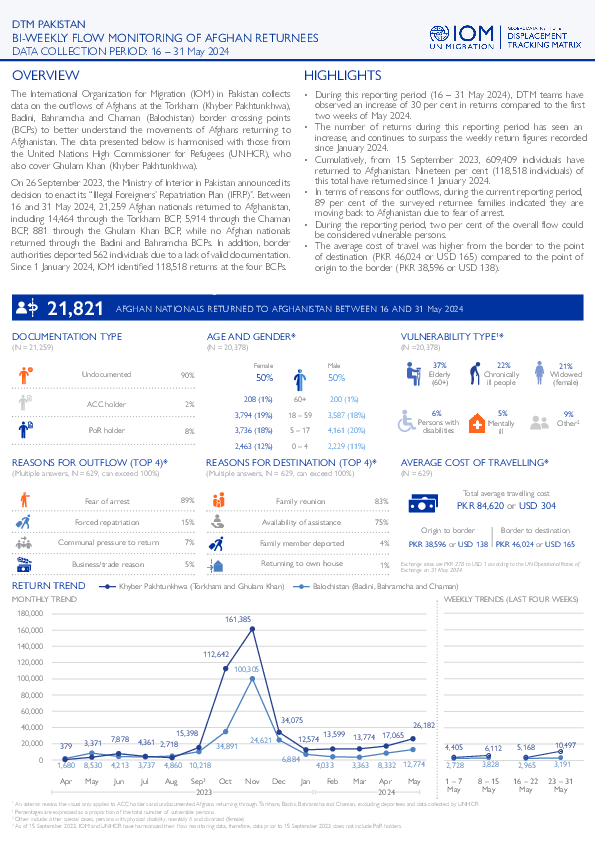
Contact
DTM Pakistan, DTMPakistan@iom.int
Language
English
Location
Pakistan
Period Covered
May 16 2024
May 31 2024
Activity
- Flow Monitoring
The International Organization for Migration (IOM) in Pakistan collects data on the outflows of Afghans at the Torkham (Khyber Pakhtunkhwa), Badini, Bahramcha and Chaman (Balochistan) border crossing points (BCPs) to better understand the movements of Afghans returning to Afghanistan. The data presented below is harmonised with those from the United Nations High Commissioner for Refugees (UNHCR), who also cover Ghulam Khan (Khyber Pakhtunkhwa).
On 26 September 2023, the Ministry of Interior in Pakistan announced its decision to enact its “Illegal Foreigners’ Repatriation Plan (IFRP)”. Between 16 and 31 May 2024, 21,259 Afghan nationals returned to Afghanistan, including 14,464 through the Torkham BCP, 5,914 through the Chaman BCP, 881 through the Ghulam Khan BCP, while no Afghan nationals returned through the Badini and Bahramcha BCPs. In addition, border authorities deported 562 individuals due to a lack of valid documentation. Since 1 January 2024, IOM identified 118,518 returns at the four BCPs.
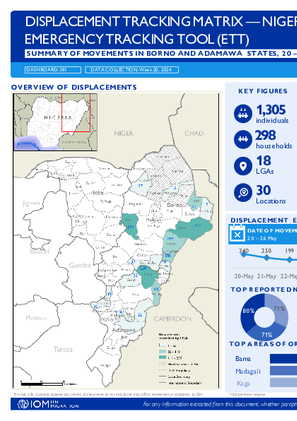
Contact
DTM Nigeria, iomnigeriadtm@iom.int
Language
English
Location
Nigeria
Period Covered
May 20 2024
May 26 2024
Activity
- Mobility Tracking
- Event Tracking
Between 20 and 26 May 2024, a total of 1,305 new arrivals were recorded at locations in Adamawa and Borno states. The new arrivals were recorded at locations in Askira/Uba, Bama, Gubio, Gwoza, Kaga, Kala Balge, Monguno and Ngala Local Government Areas (LGAs) of the most conflict-affected Borno State and in Fufore, Gombi, Guyuk, Hong, Lamurde, Madagali, Maiha, Michika, Yola North and Yola South LGAs of Adamawa State.
ETT assessments identified the following movement triggers: military operations (306 individuals or 23%), poor living conditions (275 individuals or 21%), fear of attack (245 individuals or 19%), seasonal farming (243 individuals or 19%) improved security (150 individuals or
11%) and family re-unification (86 individuals or 7%).
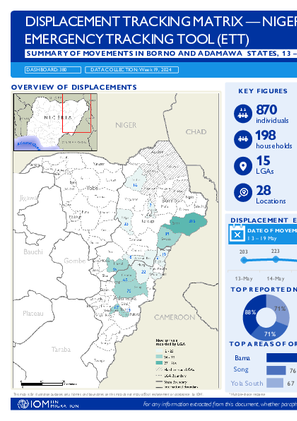
Contact
DTM Nigeria, iomnigeriadtm@iom.int
Language
English
Location
Nigeria
Period Covered
May 13 2024
May 19 2024
Activity
- Mobility Tracking
- Event Tracking
Between 13 and 19 May 2024, a total of 870 new arrivals were recorded at locations in Adamawa and Borno states. The new arrivals were recorded at locations in Askira/Uba, Bama, Gubio, Gwoza, Hawul, Jere, and Kaga Local Government Areas (LGAs) of the most conflict-affected Borno State and in Gombi, Hong, Madagali, Michika, Mubi South, Song, Yola North and Yola South LGAs of Adamawa State.
ETT assessments identified the following movement triggers: improved security (276 individuals or 32%), seasonal farming (154 individuals or 18%), military operations (143 individuals or 16%), poor living conditions (126 individuals or 14%), family re-unification (102 individuals or 12%), fear of attack (44 individuals or 5%) and attack (25 individuals or 3%).
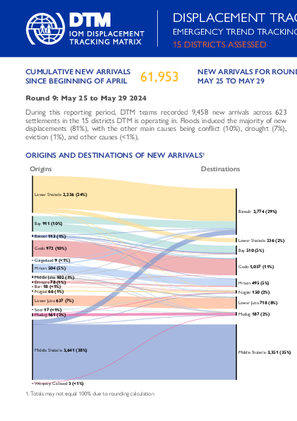
Contact
DTM Somalia, IOMSomaliaDTM@iom.int
Language
English
Location
Somalia
Period Covered
May 25 2024
May 29 2024
Activity
- Mobility Tracking
- Baseline Assessment
This latest round of Emergency Trends Tracking was initiated in April 2024 to monitor displacements movements during the Gu rainy season. Districts covered in this round include Afgooye, Afmadow, Baardheere, Baidoa, Balcad, Belet Weyne, Dayniile, Gaalkacyo, Garoowe, Hodan, Jamaame, Jowhar, Kahda, Kismaayo, Luuq.
ETT is a crisis-based tool that tracks sudden displacement triggered by specific events or emerging crises. The objective of ETT is to help prioritize humanitarian response and to enable partners to deliver rapid assistance. Based on previous shock induced displacement patterns, the humanitarian community expects that people will continue to move toward urban areas in search of humanitarian services. Consequently, the ETT coverage focuses on the main urban centers and surrounding villages for each assessed district. The data is collected through Key Informant Interviews (KIIs) at the location level, from Sunday to Wednesday every week. It includes information on new arrivals, numbers and demographic of IDPs, reasons for displacement, intentions, humanitarian assistance and priority needs among others.
The ETT tool also adapts to regional contexts: because of the very high number of IDP sites in Khada and Daynile districts in Banadir region and in Baidoa district in Bay region, a zonal approach has been adopted for these areas. Each week, KIIs are first conducted at the zone level to indicate to the field teams which locations have received the most new arrivals and which need to be assessed. To facilitate the joint analysis of the CCCM (Camp Coordination and Camp Management) Cluster’s New Arrivals Tracker (NAT) and ETT data, the assistance and needs indicators are identical in both tools.
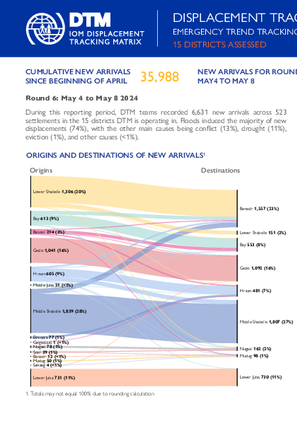
Contact
DTM Somalia, IOMSomaliaDTM@iom.int
Language
English
Location
Somalia
Period Covered
May 04 2024
May 08 2024
Activity
- Mobility Tracking
- Baseline Assessment
This latest round of Emergency Trends Tracking was initiated in April 2024 to monitor displacements movements during the Gu rainy season. Districts covered in this round include Afgooye, Afmadow, Baardheere, Baidoa, Balcad, Belet Weyne, Dayniile, Gaalkacyo, Garoowe, Hodan, Jamaame, Jowhar, Kahda, Kismaayo, Luuq.
ETT is a crisis-based tool that tracks sudden displacement triggered by specific events or emerging crises. The objective of ETT is to help prioritize humanitarian response and to enable partners to deliver rapid assistance. Based on previous shock induced displacement patterns, the humanitarian community expects that people will continue to move toward urban areas in search of humanitarian services. Consequently, the ETT coverage focuses on the main urban centers and surrounding villages for each assessed district. The data is collected through Key Informant Interviews (KIIs) at the location level, from Sunday to Wednesday every week. It includes information on new arrivals, numbers and demographic of IDPs, reasons for displacement, intentions, humanitarian assistance and priority needs among others.
The ETT tool also adapts to regional contexts: because of the very high number of IDP sites in Khada and Daynile districts in Banadir region and in Baidoa district in Bay region, a zonal approach has been adopted for these areas. Each week, KIIs are first conducted at the zone level to indicate to the field teams which locations have received the most new arrivals and which need to be assessed. To facilitate the joint analysis of the CCCM (Camp Coordination and Camp Management) Cluster’s New Arrivals Tracker (NAT) and ETT data, the assistance and needs indicators are identical in both tools.
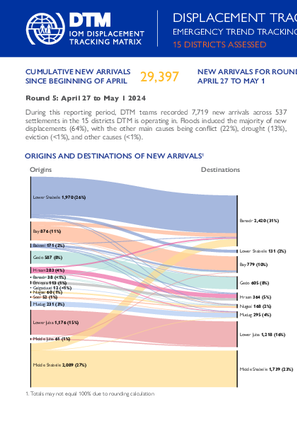
Contact
DTM Somalia, IOMSomaliaDTM@iom.int
Language
English
Location
Somalia
Period Covered
Apr 27 2024
May 01 2024
Activity
- Mobility Tracking
- Baseline Assessment
This latest round of Emergency Trends Tracking was initiated in April 2024 to monitor displacements movements during the Gu rainy season. Districts covered in this round include Afgooye, Afmadow, Baardheere, Baidoa, Balcad, Belet Weyne, Dayniile, Gaalkacyo, Garoowe, Hodan, Jamaame, Jowhar, Kahda, Kismaayo, Luuq.
ETT is a crisis-based tool that tracks sudden displacement triggered by specific events or emerging crises. The objective of ETT is to help prioritize humanitarian response and to enable partners to deliver rapid assistance. Based on previous shock induced displacement patterns, the humanitarian community expects that people will continue to move toward urban areas in search of humanitarian services. Consequently, the ETT coverage focuses on the main urban centers and surrounding villages for each assessed district. The data is collected through Key Informant Interviews (KIIs) at the location level, from Sunday to Wednesday every week. It includes information on new arrivals, numbers and demographic of IDPs, reasons for displacement, intentions, humanitarian assistance and priority needs among others.
The ETT tool also adapts to regional contexts: because of the very high number of IDP sites in Khada and Daynile districts in Banadir region and in Baidoa district in Bay region, a zonal approach has been adopted for these areas. Each week, KIIs are first conducted at the zone level to indicate to the field teams which locations have received the most new arrivals and which need to be assessed. To facilitate the joint analysis of the CCCM (Camp Coordination and Camp Management) Cluster’s New Arrivals Tracker (NAT) and ETT data, the assistance and needs indicators are identical in both tools.
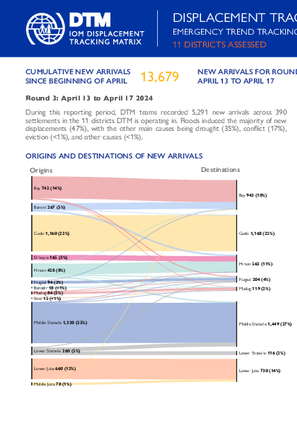
Contact
DTM Somalia, IOMSomaliaDTM@iom.int
Language
English
Location
Somalia
Period Covered
Apr 13 2024
Apr 17 2024
Activity
- Mobility Tracking
- Baseline Assessment
This latest round of Emergency Trends Tracking was initiated in April 2024 to monitor displacements movements during the Gu rainy season. Districts covered in this round include Afgooye, Afmadow, Baardheere, Baidoa, Balcad, Belet Weyne, Gaalkacyo, Garoowe, Jowhar, Kismaayo, and Luuq.
ETT is a crisis-based tool that tracks sudden displacement triggered by specific events or emerging crises. The objective of ETT is to help prioritize humanitarian response and to enable partners to deliver rapid assistance. Based on previous shock induced displacement patterns, the humanitarian community expects that people will continue to move toward urban areas in search of humanitarian services. Consequently, the ETT coverage focuses on the main urban centers and surrounding villages for each assessed district. The data is collected through Key Informant Interviews (KIIs) at the location level, from Sunday to Wednesday every week. It includes information on new arrivals, numbers and demographic of IDPs, reasons for displacement, intentions, humanitarian assistance and priority needs among others.
The ETT tool also adapts to regional contexts: because of the very high number of IDP sites in Khada and Daynile districts in Banadir region and in Baidoa district in Bay region, a zonal approach has been adopted for these areas. Each week, KIIs are first conducted at the zone level to indicate to the field teams which locations have received the most new arrivals and which need to be assessed.
To facilitate the joint analysis of the CCCM (Camp Coordination and Camp Management) Cluster’s New Arrivals Tracker (NAT) and ETT data, the assistance and needs indicators are identical in both tools.
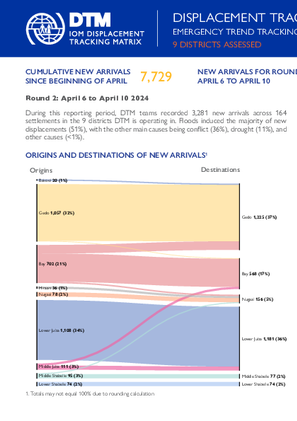
Contact
DTM Somalia, IOMSomaliaDTM@iom.int
Language
English
Location
Somalia
Period Covered
Apr 06 2024
Apr 10 2024
Activity
- Mobility Tracking
- Baseline Assessment
This latest round of Emergency Trends Tracking was initiated in April 2024 to monitor displacements movements during the Gu rainy season. Districts covered in this round include Afgooye, Afmadow, Baardheere, Baidoa, Balcad, Garoowe, Jamaame, Kismaayo, and Luuq.
ETT is a crisis-based tool that tracks sudden displacement triggered by specific events or emerging crises. The objective of ETT is to help prioritize humanitarian response and to enable partners to deliver rapid assistance. Based on previous shock induced displacement patterns, the humanitarian community expects that people will continue to move toward urban areas in search of humanitarian services. Consequently, the ETT coverage focuses on the main urban centers and surrounding villages for each assessed district. The data is collected through Key Informant Interviews (KIIs) at the location level, from Sunday to Wednesday every week. It includes information on new arrivals, numbers and demographic of IDPs, reasons for displacement, intentions, humanitarian assistance and priority needs among others. To facilitate the joint analysis of the CCCM (Camp Coordination and Camp Management) Cluster’s New Arrivals Tracker (NAT) and ETT data, the assistance and needs indicators are identical in both tools.
Pagination
- Previous page
- Page 8
- Next page